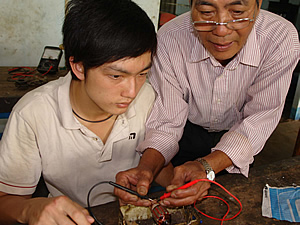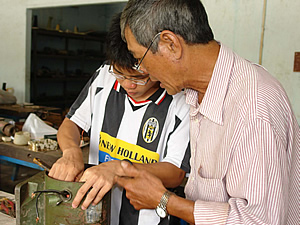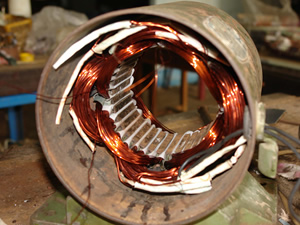 In 1995, Francis Van Hoi founded an educational centre of professional learning in Ba Thong, Hoc Mon, near Saigon. In co-operation with a mission of the Don Bosco Salesians – where he himself went to school more than 40 years ago – the centre initially provided an education in the crafts for 10 street children. By now, the number has increased to between 20 and 30 each semester. We are talking between two and six months during which the young people are to be enabled to go home and work for their own livelihoods. In Vietnam, too, accommodation, food and education cost money, regardless of the support by the Salesians.
In 1995, Francis Van Hoi founded an educational centre of professional learning in Ba Thong, Hoc Mon, near Saigon. In co-operation with a mission of the Don Bosco Salesians – where he himself went to school more than 40 years ago – the centre initially provided an education in the crafts for 10 street children. By now, the number has increased to between 20 and 30 each semester. We are talking between two and six months during which the young people are to be enabled to go home and work for their own livelihoods. In Vietnam, too, accommodation, food and education cost money, regardless of the support by the Salesians.
 Money which Francis Van Hoi initially drew exclusively from the profit his own food markets and import-export business made. Being a businessman, he – probably unlike the Salesian brothers – saw potential for improvement in this situation. Consequently, he always also came up with business ideas when visiting.
Money which Francis Van Hoi initially drew exclusively from the profit his own food markets and import-export business made. Being a businessman, he – probably unlike the Salesian brothers – saw potential for improvement in this situation. Consequently, he always also came up with business ideas when visiting.
In Vietnam, too, especially in the south, the economic growth provides a small part of the population with considerable wealth. One of the preferred symbols of wealth is an spectacular-looking house, often in a sort of modernized colonial style.

The huge, slowly moving ventilators fastened to the ceilings with their wooden fan blades that were first used in those times are an almost indispensable accessory. To be sure, the growing Vietnamese industry produced masses of ventilators – yet unfortunately all of those are the modern, unadorned, mostly white metal/plastic variety. People who aspired to gentrification preferred to have something antique hanging from the ceiling.
That was a lucky coincidence, because the old ventilators were lying around in huge numbers. Most of them had been discarded because they had broken down at some time or other. They were an ideal object for use in an educational workshop specialising on electronics and mechanics. So, after appropriate payment for the old devices, the motors and whatever else had remained intact were completely re-built. With the most basic equipment, the workshop made new windings for the anchors and commutators, repaired bearings and much more.
 This first project was followed by many more, often in the field of motorized technique (as the pictures show). By now, the cost for the educational programs of the centre, including personnel, is earned by the centre itself, and it has such a good reputation that the number of applicants is getting too high for the few available openings. Some applicants even come from well-endowed families. Not being part of the original group of people for whom the place was established, these young people have to be denied.
This first project was followed by many more, often in the field of motorized technique (as the pictures show). By now, the cost for the educational programs of the centre, including personnel, is earned by the centre itself, and it has such a good reputation that the number of applicants is getting too high for the few available openings. Some applicants even come from well-endowed families. Not being part of the original group of people for whom the place was established, these young people have to be denied.
It is one of the goals of Francis Van Hoi – he is currently staying there and took the pictures himself – to extend the centre. One of his reasons is that he wishes to be less of a burden to the Salesians, who still provide rooms and infra-structure for the project. Aid from outside is welcome – because he would very much like to use the profits made by the new fish-sauce deal elsewhere. But that is something I will write about in my next letter. …
MS
(Translated by EG)
